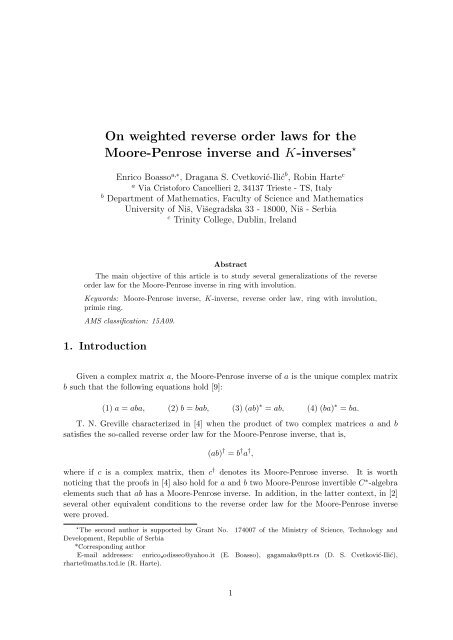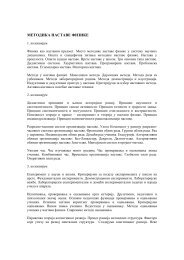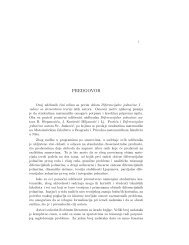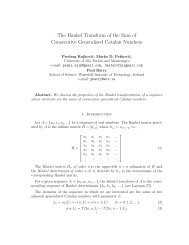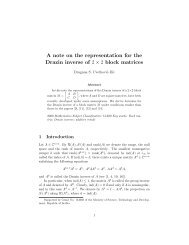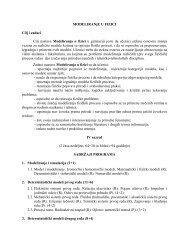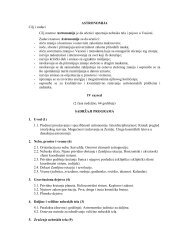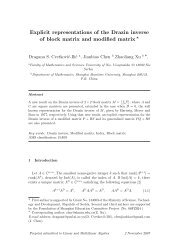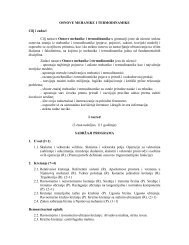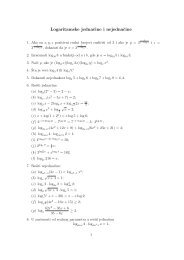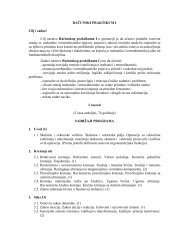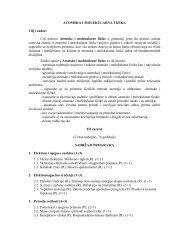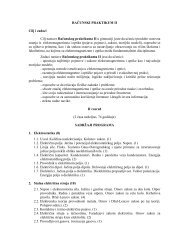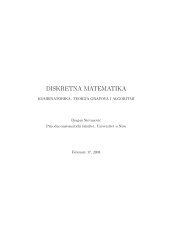On weighted reverse order laws for the Moore-Penrose inverse and ...
On weighted reverse order laws for the Moore-Penrose inverse and ...
On weighted reverse order laws for the Moore-Penrose inverse and ...
You also want an ePaper? Increase the reach of your titles
YUMPU automatically turns print PDFs into web optimized ePapers that Google loves.
<strong>On</strong> <strong>weighted</strong> <strong>reverse</strong> <strong>order</strong> <strong>laws</strong> <strong>for</strong> <strong>the</strong><br />
<strong>Moore</strong>-<strong>Penrose</strong> <strong>inverse</strong> <strong>and</strong> K-<strong>inverse</strong>s ⋆<br />
Enrico Boasso a,∗ , Dragana S. Cvetković-Ilić b , Robin Harte c<br />
a Via Cristo<strong>for</strong>o Cancellieri 2, 34137 Trieste - TS, Italy<br />
b Department of Ma<strong>the</strong>matics, Faculty of Science <strong>and</strong> Ma<strong>the</strong>matics<br />
University of Niš, Višegradska 33 - 18000, Niš - Serbia<br />
c Trinity College, Dublin, Irel<strong>and</strong><br />
Abstract<br />
The main objective of this article is to study several generalizations of <strong>the</strong> <strong>reverse</strong><br />
<strong>order</strong> law <strong>for</strong> <strong>the</strong> <strong>Moore</strong>-<strong>Penrose</strong> <strong>inverse</strong> in ring with involution.<br />
Keywords: <strong>Moore</strong>-<strong>Penrose</strong> <strong>inverse</strong>, K-<strong>inverse</strong>, <strong>reverse</strong> <strong>order</strong> law, ring with involution,<br />
primie ring.<br />
AMS classification: 15A09.<br />
1. Introduction<br />
Given a complex matrix a, <strong>the</strong> <strong>Moore</strong>-<strong>Penrose</strong> <strong>inverse</strong> of a is <strong>the</strong> unique complex matrix<br />
b such that <strong>the</strong> following equations hold [9]:<br />
(1) a = aba, (2) b = bab, (3) (ab) ∗ = ab, (4) (ba) ∗ = ba.<br />
T. N. Greville characterized in [4] when <strong>the</strong> product of two complex matrices a <strong>and</strong> b<br />
satisfies <strong>the</strong> so-called <strong>reverse</strong> <strong>order</strong> law <strong>for</strong> <strong>the</strong> <strong>Moore</strong>-<strong>Penrose</strong> <strong>inverse</strong>, that is,<br />
(ab) † = b † a † ,<br />
where if c is a complex matrix, <strong>the</strong>n c † denotes its <strong>Moore</strong>-<strong>Penrose</strong> <strong>inverse</strong>. It is worth<br />
noticing that <strong>the</strong> proofs in [4] also hold <strong>for</strong> a <strong>and</strong> b two <strong>Moore</strong>-<strong>Penrose</strong> invertible C ∗ -algebra<br />
elements such that ab has a <strong>Moore</strong>-<strong>Penrose</strong> <strong>inverse</strong>. In addition, in <strong>the</strong> latter context, in [2]<br />
several o<strong>the</strong>r equivalent conditions to <strong>the</strong> <strong>reverse</strong> <strong>order</strong> law <strong>for</strong> <strong>the</strong> <strong>Moore</strong>-<strong>Penrose</strong> <strong>inverse</strong><br />
were proved.<br />
⋆ The second author is supported by Grant No. 174007 of <strong>the</strong> Ministry of Science, Technology <strong>and</strong><br />
Development, Republic of Serbia<br />
*Corresponding author<br />
E-mail addresses: enrico odisseo@yahoo.it (E. Boasso), gagamaka@ptt.rs (D. S. Cvetković-Ilić),<br />
rharte@maths.tcd.ie (R. Harte).<br />
1
E. Boasso, D. S. Cvetković-Ilić, R. Harte 2<br />
In <strong>the</strong> frame of rings with involution, J. J. Koliha, D. Djordjević <strong>and</strong> D. Cvetković extended<br />
<strong>the</strong> characterization of [4] under <strong>the</strong> additional assumption of <strong>the</strong> ∗-left cancellation<br />
property of a particular elment of <strong>the</strong> ring, see [7].<br />
The first objective of <strong>the</strong> present article is to study a generalization of <strong>the</strong> <strong>reverse</strong> <strong>order</strong><br />
law <strong>for</strong> <strong>the</strong> <strong>Moore</strong>-<strong>Penrose</strong> <strong>inverse</strong>, namely, given R a ring with involution <strong>and</strong> a <strong>and</strong> b ∈ R<br />
such that a, b <strong>and</strong> ab are <strong>Moore</strong>-<strong>Penrose</strong> invertible, to characterize when <strong>the</strong> following identity<br />
holds:<br />
(ab) † = cb † a † ,<br />
where c ∈ R is such that c commutes with b <strong>and</strong> b ∗ . This identity <strong>and</strong> o<strong>the</strong>rs presented in<br />
section 2 will be called <strong>weighted</strong> <strong>reverse</strong> <strong>order</strong> <strong>laws</strong> <strong>for</strong> <strong>the</strong> <strong>Moore</strong>-<strong>Penrose</strong> <strong>inverse</strong>.<br />
Naturally, when c = e a characterization of <strong>the</strong> usual <strong>reverse</strong> <strong>order</strong> law is obtained. Fur<strong>the</strong>rmore,<br />
o<strong>the</strong>r similar generalizations of <strong>the</strong> <strong>reverse</strong> <strong>order</strong> law <strong>for</strong> <strong>the</strong> <strong>Moore</strong>-<strong>Penrose</strong> <strong>inverse</strong><br />
in rings with involution <strong>and</strong> in complex algebras with involution will be also considered, see<br />
next section. To this end, some ideas of [2] will be recovered. Note that no additional<br />
assumption such as <strong>the</strong> ∗-cancellation property <strong>for</strong> elements of <strong>the</strong> ring is needed.<br />
<strong>On</strong> <strong>the</strong> o<strong>the</strong>r h<strong>and</strong>, given a C ∗ -algebra A, a ∈ A <strong>and</strong> K ⊆ {1, 2, 3, 4}, an element x ∈ A<br />
is said to be a K-<strong>inverse</strong> of a, if x satisfies <strong>the</strong> <strong>Moore</strong>-<strong>Penrose</strong> equation (j) <strong>for</strong> each j ∈ K.<br />
In [3] several <strong>reverse</strong> <strong>order</strong> <strong>laws</strong> <strong>for</strong> K-<strong>inverse</strong>s of products of two C ∗ -algebra elements were<br />
characterized. The second objective of this work to extend <strong>the</strong> results of [3] to prime rings<br />
with involution including <strong>the</strong> <strong>weighted</strong> case, see section 3.<br />
Be<strong>for</strong>e going on, several definitions <strong>and</strong> some notation will be recalled.<br />
Let R be an associative ring with unit element e. The ring R is said to be a prime ring, if<br />
given a <strong>and</strong> b ∈ R such that aRb = {0}, <strong>the</strong>n 0 ∈ {a, b}. For example, if H is a Hilbert space<br />
<strong>and</strong> R = L(H), <strong>the</strong> algebra of all operators defined on <strong>and</strong> with values in H, <strong>the</strong>n it is not<br />
difficult to prove that R is a prime ring, see [1, Lemma 3] <strong>for</strong> <strong>the</strong> case of complex matrices.<br />
An element a ∈ R is said to be group invertible, if <strong>the</strong>re exists b ∈ R such that<br />
aba = a, bab = b, ab = ba.<br />
It is well known that if a ∈ R is group invertible, <strong>the</strong>n <strong>the</strong>re is only one group <strong>inverse</strong> of a,<br />
see [8]. When a ∈ R has a group <strong>inverse</strong>, it will be denoted by a ♯ .<br />
An involution ∗ : R → R is an anti-isomorphism of degree 2, that is<br />
(a ∗ ) ∗ = a, (a + b) ∗ = a ∗ + b ∗ , (ab) ∗ = b ∗ a ∗ .<br />
An element a ∈ R is said to be Hermitian, if a = a ∗ . In addition, a is said to be <strong>Moore</strong>-<br />
<strong>Penrose</strong> invertible, if <strong>the</strong>re exists b ∈ R such that a <strong>and</strong> b satisfy <strong>the</strong> <strong>Moore</strong>-<strong>Penrose</strong> <strong>inverse</strong><br />
equations presented above.<br />
It is well known that given a ∈ R, <strong>the</strong>re is at most one <strong>Moore</strong>-<strong>Penrose</strong> <strong>inverse</strong> of a, see<br />
[10]. When <strong>the</strong> <strong>Moore</strong>-<strong>Penrose</strong> <strong>inverse</strong> of a ∈ R exists, it will be denoted, as be<strong>for</strong>e, by a † .<br />
In addition, R † will st<strong>and</strong> <strong>for</strong> <strong>the</strong> set of all <strong>Moore</strong>-<strong>Penrose</strong> invertible elements of a ∈ R. Note<br />
that if a ∈ R † , <strong>the</strong>n aa † <strong>and</strong> a † a are hermitian idempotents. What is more, if a ∈ R † , <strong>the</strong>n<br />
a † ∈ R † <strong>and</strong> (a † ) † = a. Moreover, it is easy to prove that a ∈ R † if <strong>and</strong> only if a ∗ ∈ R † .<br />
Fur<strong>the</strong>rmore, in this case, (a ∗ ) † = (a † ) ∗ . In what follows, (a † ) ∗ will be denoted by a †∗ .
E. Boasso, D. S. Cvetković-Ilić, R. Harte 3<br />
Given a ∈ R <strong>and</strong> K ⊆ {1, 2, 3, 4}, x ∈ R will be said to be a K-<strong>inverse</strong> of a, if x satisfies<br />
<strong>the</strong> same condition recalled above <strong>for</strong> C ∗ -algebra elements. The set of all K-<strong>inverse</strong>s of a<br />
given a ∈ R will be denoted by aK.<br />
Finally, if p <strong>and</strong> q are idempotents in R, <strong>the</strong>n an arbitrary x ∈ R can be represented as<br />
a 2 × 2 matrix over R. In fact, [ ]<br />
x1 x<br />
x =<br />
2<br />
,<br />
x 3 x 4<br />
where x 1 = pxq, x 2 = px(e − q), x 3 = (e − p)xq <strong>and</strong> x 4 = (e − p)x(e − q).<br />
x = x 1 + x 2 + x 3 + x 4 .<br />
p,q<br />
Note that<br />
2. Weighted <strong>reverse</strong> <strong>order</strong> <strong>laws</strong> <strong>for</strong> <strong>the</strong> <strong>Moore</strong>-<strong>Penrose</strong> <strong>inverse</strong><br />
We begin by presenting an equivalent <strong>for</strong>mulation <strong>for</strong> <strong>the</strong> <strong>Moore</strong>-<strong>Penrose</strong> <strong>inverse</strong>. Although<br />
its proof is not difficult [9], it will be used in some results of this article, <strong>and</strong> hence<br />
we reproduce it here.<br />
Proposition 2.1. Let R be a ring with involution <strong>and</strong> consider a ∈ R. Then, <strong>the</strong> following<br />
statements are equivalent:<br />
(i) b ∈ R is <strong>the</strong> <strong>Moore</strong>-<strong>Penrose</strong> <strong>inverse</strong> of a;<br />
(ii) a = aa ∗ b ∗ <strong>and</strong> b ∗ = abb ∗ .<br />
Proof. If b = a † <strong>the</strong>n, since (ab) ∗ = ab,<br />
a = aba = a(ba) = a(ba) ∗ = aa ∗ b ∗ , b ∗ = (bab) ∗ = (ab) ∗ b ∗ = abb ∗ .<br />
<strong>On</strong> <strong>the</strong> o<strong>the</strong>r h<strong>and</strong>, if <strong>the</strong> second statement holds, <strong>the</strong>n<br />
ba = baa ∗ b ∗ = ba(ba) ∗ , (ab) ∗ = b ∗ a ∗ = abb ∗ a ∗ = ab(ab) ∗ ,<br />
equivalently, ab <strong>and</strong> ba are hermitian idempotents. However, according to statement (ii),<br />
a = aba,<br />
b = bb ∗ a ∗ = bab.<br />
The following proposition will extend to rings with involution a well known result concerning<br />
<strong>the</strong> <strong>Moore</strong>-<strong>Penrose</strong> <strong>inverse</strong> of C ∗ -algebra elements, see [5, Theorem 7].<br />
Proposition 2.2. Let R be a ring with involution <strong>and</strong> consider a ∈ R † <strong>and</strong> c ∈ R. Necessary<br />
<strong>and</strong> sufficient condition <strong>for</strong> c to commute with a <strong>and</strong> a ∗ is that c commutes with a † <strong>and</strong> a †∗ .<br />
Proof. Let a ∈ R † . Then, according to [6, Theorem 5.3], (a ∗ a) ♯ exists. Moreover,<br />
a † = (a ∗ a) ♯ a ∗ .<br />
Now well, since c commutes with a <strong>and</strong> a ∗ , <strong>the</strong>n c commutes with a ∗ a. In addition, since<br />
a ∗ a is group invertible, c commutes with (a ∗ a) ♯ , see [8]. There<strong>for</strong>e, according to [6, Theorem<br />
5.3], c commutes with a † .
E. Boasso, D. S. Cvetković-Ilić, R. Harte 4<br />
In addition, since a ∗ ∈ R † <strong>and</strong> (a ∗ ) ∗ = a, according to what has been proved, c commutes<br />
with (a ∗ ) † = a †∗ .<br />
<strong>On</strong> <strong>the</strong> o<strong>the</strong>r h<strong>and</strong>, if c commutes with a † <strong>and</strong> a †∗ , <strong>the</strong>n since (a † ) † = a <strong>and</strong> (a † ) †∗ = a ∗ ,<br />
c commutes with a <strong>and</strong> a ∗ .<br />
Let R be a ring with involution <strong>and</strong> consider a, b ∈ R † . Define p = bb † , q = a † a †∗ ,<br />
r = bb ∗ <strong>and</strong> s = a † a. Note that p, q, r <strong>and</strong> s are hermitian elements. Moreover, according to<br />
Proposition 2.1, a = as, a †∗ = aq, b = rb †∗ <strong>and</strong> b †∗ = pb †∗ .<br />
In <strong>the</strong> following <strong>the</strong>orems several <strong>weighted</strong> <strong>reverse</strong> <strong>order</strong> <strong>laws</strong> <strong>for</strong> <strong>the</strong> <strong>Moore</strong>-<strong>Penrose</strong> <strong>inverse</strong><br />
will be presented. Note that when c = e, <strong>the</strong>n a characterization of <strong>the</strong> usual <strong>reverse</strong><br />
<strong>order</strong> law in rings with involution is obtained.<br />
Theorem 2.3. Let R be a ring with involution. Considera, b ∈ R † such that ab ∈ R † , <strong>and</strong><br />
c ∈ R such that c commutes with b <strong>and</strong> b ∗ . Then, <strong>the</strong> following statements are equivalent:<br />
(i) (ab) † = cb † a † ;<br />
(ii) a(cpq − qp)b †∗ c ∗ = 0 <strong>and</strong> a(rsc ∗ − sr)b †∗ = 0;<br />
(iii) scpqpc ∗ = qpc ∗ <strong>and</strong> srspc ∗ = sr.<br />
Proof. In first place, note that according to Proposition 2.1,<br />
a = aa ∗ a †∗ , b = bb ∗ b †∗ , ab = ab(ab) ∗ (ab) †∗ ,<br />
a †∗ = aa † a †∗ , b †∗ = bb † b †∗ , (ab) †∗ = ab(ab) † (ab) †∗ .<br />
Now suppose that (ab) † = cb † a † . Then, since (ab) ∗ = b ∗ a ∗ <strong>and</strong> (ab) †∗ = (cb † a † ) ∗ =<br />
a †∗ b †∗ c ∗ ,<br />
ab = abb ∗ a ∗ a †∗ b †∗ c ∗ , a †∗ b †∗ c ∗ = abcb † a † a †∗ b †∗ c ∗ ,<br />
which, since c <strong>and</strong> b commute, can be written as<br />
asrb †∗ = arsb †∗ c ∗ , aqpb †∗ c ∗ = acpqb †∗ c ∗ .<br />
However, according to Proposition 2.2 <strong>the</strong>se identities are equivalent to<br />
a(cpq − qp)b †∗ c ∗ = 0, a(rsc ∗ − sr)b †∗ = 0.<br />
If <strong>the</strong> second statement holds, <strong>the</strong>n<br />
a † acpqb †∗ c ∗ b ∗ = a † aqpb †∗ c ∗ b ∗ , a † arsc ∗ b †∗ b ∗ = a † asrb †∗ b ∗ .<br />
However, since c commutes with b <strong>and</strong> b † ,<br />
a † acpqb †∗ b ∗ c ∗ = a † aqpb †∗ b ∗ c ∗ , a † arsb †∗ b ∗ c ∗ = a † asrb †∗ b ∗ .<br />
What is more, according again to Proposition 2.1 <strong>and</strong> to <strong>the</strong> fact that s = s ∗ <strong>and</strong> p = p ∗ ,<br />
<strong>the</strong>se equations can be rewritten as<br />
scpqpc ∗ = a † (aa † a †∗ )b(b † b †∗ b ∗ )c ∗ = a † a †∗ bb † c ∗ = qpc ∗ ,
E. Boasso, D. S. Cvetković-Ilić, R. Harte 5<br />
srspc ∗ = (a † aa ∗ )a †∗ (bb ∗ b †∗ )b ∗ = a ∗ a †∗ bb ∗ = sr.<br />
Next suppose that statement (iii) holds. Then, since p = p ∗ , s = s ∗ <strong>and</strong> b <strong>and</strong> c commute,<br />
a † abcb † a † a †∗ b †∗ b ∗ c ∗ = a † a †∗ bb † c ∗ ,<br />
a † abb ∗ a ∗ a †∗ b †∗ b ∗ c ∗ = a ∗ a †∗ bb ∗ .<br />
Moreover, since c <strong>and</strong> b † commute,<br />
(aa † a)bcb † a † a †∗ (b †∗ b ∗ b †∗ )c ∗ = (aa † a †∗ )(bb † b †∗ )c ∗ ,<br />
(aa † a)bb ∗ a ∗ a †∗ (b †∗ b ∗ b †∗ )c ∗ = (aa ∗ a †∗ )(bb ∗ b †∗ ).<br />
However, according to Proposition 2.1, <strong>the</strong>se equations are equivalent to<br />
ab(cb † a † )(cb † a † ) ∗ = (cb † a † ) ∗ ,<br />
ab(ab) ∗ (cb † a † ) ∗ = ab.<br />
There<strong>for</strong>e,<br />
(ab) † = cb † a † .<br />
As an application of Theorem 2.3, o<strong>the</strong>r generalizations of <strong>the</strong> <strong>reverse</strong> <strong>order</strong> law can be<br />
characterized.<br />
Theorem 2.4. Let R be a ring with involution. Consider a, b ∈ R † such that ab ∈ R † , <strong>and</strong><br />
c ∈ R such that c commutes with a <strong>and</strong> a ∗ . Then, <strong>the</strong> following statements are equivalent:<br />
(i) (ab) † = b † a † c;<br />
(ii) b ∗ (c ∗ sr † − r † s)a † c = 0 <strong>and</strong> b ∗ (q † pc − pq † )a † = 0;<br />
(iii) pc ∗ sr † sc = r † sc <strong>and</strong> pq † psc = pq † .<br />
Proof. Recall that given h ∈ R, necessary <strong>and</strong> sufficient <strong>for</strong> h to belong to R † is that h ∗ ∈ R † ,<br />
(see [6, Theorem 5.4]). Moreover, in this case (h ∗ ) † = (h † ) ∗ . It is not difficult to prove that<br />
<strong>the</strong> identity (ab) † = b † a † c is equivalent to<br />
(b ∗ a ∗ ) † = c ∗ (a ∗ ) † (b ∗ ) † .<br />
<strong>On</strong> <strong>the</strong> o<strong>the</strong>r h<strong>and</strong>, denote by p 1 , q 1 , r 1 <strong>and</strong> s 1 <strong>the</strong> elements of R corresponding to p, q,<br />
r <strong>and</strong> s defined using b ∗ a ∗ instead of ab. Then, it is easy to prove that<br />
p 1 = s, s 1 = p.<br />
In addition, according to <strong>the</strong> proof of [6, Theorem 5.3],<br />
q 1 = r † , r 1 = q † .<br />
To conclude <strong>the</strong> proof, apply Theorem 2.3 to b ∗ , a ∗ , b ∗ a ∗ <strong>and</strong> c ∗ .
E. Boasso, D. S. Cvetković-Ilić, R. Harte 6<br />
Theorem 2.5. Let R be a ring with involution. Consider a, b ∈ R † <strong>and</strong> c ∈ R such that<br />
cab ∈ R † . Then, if c commutes with a <strong>and</strong> a ∗ , <strong>the</strong> following statements are equivalent:<br />
(i) (cab) † = b † a † ;<br />
(ii) b † (csr − rs)a ∗ c ∗ = 0 <strong>and</strong> b † (qpc ∗ − pq)a ∗ = 0;<br />
(iii) pcsrsc ∗ = rsc ∗ <strong>and</strong> pqpsc ∗ = pq.<br />
Proof. Note that cab ∈ R † <strong>and</strong> (cab) † = b † a † if <strong>and</strong> only if b † a † ∈ R † <strong>and</strong> (b † a † ) † = cab.<br />
As in <strong>the</strong> proof of Theorem 2.4, p 2 , q 2 , r 2 <strong>and</strong> s 2 denote <strong>the</strong> elements of R corresponding<br />
to p, q, r <strong>and</strong> s defined using b † a † instead of ab. Then, it is easy to prove that<br />
p 2 = s, q 2 = r, r 2 = q, s 2 = p.<br />
To conclude <strong>the</strong> proof, apply Theorem 2.3 to b † , a † , b † a † <strong>and</strong> c.<br />
Theorem 2.6. Let R be a ring with involution. Consider a, b ∈ R † <strong>and</strong> c ∈ R such that<br />
abc ∈ R † . Then, if c commutes with b <strong>and</strong> b ∗ , <strong>the</strong> following statements are equivalent:<br />
(i) (abc) † = b † a † ;<br />
(ii) a †∗ (c ∗ pq † − q † p)bc = 0 <strong>and</strong> a †∗ (r † sc − sr † )b = 0;<br />
(iii) sc ∗ pq † pc = q † pc <strong>and</strong> sr † spc = sr † .<br />
Proof. It is easy to prove that <strong>the</strong> first statement is equivalent to<br />
(a †∗ b †∗ ) † = c ∗ b ∗ a ∗ .<br />
As in Theorem 2.4 <strong>and</strong> Theorem 2.5, denote by p 3 , q 3 , r 3 <strong>and</strong> s 3 <strong>the</strong> elements of R<br />
corresponding to p, q, r <strong>and</strong> s defined using a †∗ b †∗ instead of ab. Then, using <strong>the</strong> proof of [6,<br />
Theorem 5.3],we prove that<br />
p 3 = p, q 3 = q † , r 3 = r † , s 3 = s.<br />
To conclude <strong>the</strong> proof, apply Theorem 2.3 to a †∗ , b †∗ , a †∗ b †∗ <strong>and</strong> c ∗ .<br />
Now, <strong>the</strong> case of an algebra with involution over <strong>the</strong> complex numbers C will be considered.<br />
Note that if λ ∈ C, <strong>the</strong>n λ ∈ C will denote <strong>the</strong> conjugate of λ.<br />
Corollary 2.7. Let A be an algebra with involution over C. Consider a, b ∈ A † such that<br />
ab ∈ A † , <strong>and</strong> λ ∈ C. Then, <strong>the</strong> following statements are equivalent:<br />
(i) (ab) † = λb † a † ;<br />
(ii) a(λpq − qp)b †∗ = 0 <strong>and</strong> a(rsλ − sr)b †∗ = 0;<br />
(iii) λspqp = qp <strong>and</strong> λsrsp = sr.<br />
Proof. Apply Theorem 2.3.<br />
Remark 2.8. Let A be a C ∗ -algebra <strong>and</strong> consider a, b ∈ A † such that ab ∈ A † . Let p,<br />
q, r <strong>and</strong> s be <strong>the</strong> elements of A defined be<strong>for</strong>e Theorem 2.3. Recall that, according to [2,<br />
Remark 3.5] or [4], (ab) † = b † a † if <strong>and</strong> only if rs = sr <strong>and</strong> pq = qp. Note that according<br />
to [5, Theorem 7], p <strong>and</strong> q commute (respectively r <strong>and</strong> s commute) if <strong>and</strong> only if p <strong>and</strong> q †<br />
commute (respectively s <strong>and</strong> r † commute). What is more, <strong>the</strong>se statements are equivalent to<br />
<strong>the</strong> at first sight weaker conditions of [2, Theorems 3.1-3.4].
E. Boasso, D. S. Cvetković-Ilić, R. Harte 7<br />
When R a ring with involution, a, b ∈ R † <strong>and</strong> (1 − a † a)b is left ∗-cancellable, necessary<br />
<strong>and</strong> sufficient <strong>for</strong> ab to belong to R † <strong>and</strong> (ab) † = b † a † is that rs = sr <strong>and</strong> pq † = q † p (see [7,<br />
Theorem 3]). Note also that according to Proposition 2.2, p <strong>and</strong> q commute (respectively r<br />
<strong>and</strong> s commute) if <strong>and</strong> only if p <strong>and</strong> q † commute (respectively s <strong>and</strong> r † commute). There<strong>for</strong>e,<br />
considering c = e, <strong>the</strong> conditions presented in Theorem 2.3 are weaker than <strong>the</strong> ones in [7,<br />
Theorem 3] <strong>and</strong> to prove <strong>the</strong>m <strong>the</strong> cancellation property is not necessary. In particular,<br />
while all <strong>the</strong> a<strong>for</strong>ementioned resuts are equivalent in C ∗ -algebras, in <strong>the</strong> case of rings with<br />
involution, according to <strong>the</strong> characterization of Theorem 2.3, if <strong>the</strong> <strong>reverse</strong> <strong>order</strong> law is<br />
satisfied by a <strong>and</strong> b, <strong>the</strong> identities rs = sr <strong>and</strong> pq † = q † p need not to be satisfied. According<br />
to [7, Theorem 3], <strong>the</strong>se equalities are satisfied when <strong>the</strong> cancellation property is assumed.<br />
3. Weighted <strong>reverse</strong> <strong>order</strong> <strong>laws</strong> <strong>for</strong> K-<strong>inverse</strong>s in prime rings<br />
In this section, R will be a prime ring with involution <strong>and</strong> K ⊆ {1, 2, 3, 4}. For a, b ∈ R,<br />
several <strong>weighted</strong> <strong>reverse</strong> <strong>order</strong> <strong>laws</strong> <strong>for</strong> K-<strong>inverse</strong>s of ab will be characterized. First we will<br />
present some preliminary facts.<br />
Remark 3.1. Consider a, b ∈ R † <strong>and</strong> c ∈ R such[ that c]<br />
commutes with [ a <strong>and</strong> ] a ∗ . Let<br />
b 0<br />
p = bb † , q = b † b <strong>and</strong> r = aa † a1 a<br />
. We have that b =<br />
<strong>and</strong> a =<br />
2<br />
. An<br />
0 0<br />
0 0<br />
[ ]<br />
p,q<br />
r,p<br />
b<br />
arbitrary b (1,3) ∈ b{1, 3} has <strong>the</strong> <strong>for</strong>m b (1,3) †<br />
0<br />
=<br />
, <strong>for</strong> some u ∈ (e − q)Ap <strong>and</strong><br />
u v<br />
q,p<br />
v ∈ (e<br />
[<br />
− q)A(e<br />
]<br />
− p), <strong>and</strong> an arbitrary<br />
[<br />
a (1,3) has<br />
]<br />
<strong>the</strong> <strong>for</strong>m a (1,3) = a † + (e − a † a)x, <strong>for</strong> some<br />
x1 x<br />
x =<br />
2<br />
∈ R, i.e., a<br />
x 3 x (1,3) z1 z<br />
= 2<br />
, where<br />
4 z 3 z 4<br />
p,r<br />
p,r<br />
z 1 = a ∗ 1d † + (e − a ∗ 1d † a 1 )x 1 − a ∗ 1d † a 2 x 3 ,<br />
z 2 = (e − a ∗ 1d † a 1 )x 2 − a ∗ 1d † a 2 x 4 ,<br />
z 3 = a ∗ 2d † − a ∗ 2d † a 1 x 1 + (e − a ∗ 2d † a 2 )x 3 ,<br />
z 4 = −a ∗ 2d † a 1 x 2 + (e − a ∗ 2d † a 2 )x 4 .<br />
[ a<br />
Also, a † = a ∗ (aa ∗ ) † ∗<br />
= 1 d † ]<br />
0<br />
a ∗ ([6, Theorem 5.3]), where d = aa<br />
2 d† 0<br />
∗ = a 1 a ∗ 1 + a 2a ∗ 2<br />
<strong>and</strong> d † = (aa ∗ ) † .<br />
If c commutes with a <strong>and</strong> a ∗ , it follows that c =<br />
p,r<br />
[ ]<br />
c1 0<br />
0 c 2<br />
Theorem 3.2. Let R be a prime ring with involution. Consider a, b ∈ R † <strong>and</strong> c ∈ R such<br />
that c commutes with a <strong>and</strong> a ∗ . Then, following statements are equivalent:<br />
(i) b{1, 3} · a{1, 3} · c ⊆ (ab){1, 3};<br />
(ii) b † a † c ∈ ab{1, 3}, b † a † ∈ ab{1} <strong>and</strong> a † ∈ a(e − bb † ){1}.<br />
Proof. Note that <strong>the</strong> case ab = 0 is trivial. Hence, we will consider <strong>the</strong> case ab ≠ 0.<br />
r,r<br />
.<br />
(1)
E. Boasso, D. S. Cvetković-Ilić, R. Harte 8<br />
Clearly b{1, 3}·a{1, 3}·c ⊆ (ab){1, 3} is equivalent to <strong>the</strong> fact that <strong>for</strong> any a (1,3) ∈ a{1, 3}<br />
<strong>and</strong> any b (1,3) ∈ b{1, 3}:<br />
b (1,3) a (1,3) c ∈ (ab){1, 3}. (2)<br />
to<br />
Using <strong>the</strong> matrix representations considered in Remark 3.1, we have that (2) is equivalent<br />
(i) a 1 z 1 c 1 a 1 = a 1 , (ii) a 1 z 2 c 2 = 0, (iii) (a 1 z 1 c 1 ) ∗ = a 1 z 1 c 1 , (3)<br />
where z 1 <strong>and</strong> z 2 are defined by (1). Now, using (1), <strong>the</strong> identity (3)(i) is equivalent to<br />
a 1 a ∗ 1d † c 1 a 1 + (a 1 − a 1 a ∗ 1d † a 1 )x 1 c 1 a 1 − a 1 a ∗ 1d † a 2 x 3 c 1 a 1 = a 1 . (4)<br />
Since, x 1 <strong>and</strong> x 3 are arbitrary elements from appropriate subalgebras, (3)(i) is equivalent to<br />
(i) a 1 a ∗ 1d † c 1 a 1 = a 1 , (ii) (a 1 − a 1 a ∗ 1d † a 1 )x 1 c 1 a 1 = 0, (iii) a 1 a ∗ 1d † a 2 x 3 c 1 a 1 = 0. (5)<br />
What is more, since a 1 = rap, x 1 = pxr <strong>and</strong> c 1 = rcr, (5)(ii) is equivalent to<br />
(a 1 − a 1 a ∗ 1d † a 1 )xc 1 a 1 = 0,<br />
where x ∈ R is arbitrary. However, since R is a prime ring, a 1 − a 1 a ∗ 1 d† a 1 = 0 or c 1 a 1 = 0.<br />
Similarly, from (5)(iii), we get that a 1 a ∗ 1 d† a 2 = 0 or c 1 a 1 = 0.<br />
Note that <strong>the</strong> case c 1 a 1 = 0 imply that ab = 0, which is not possible.<br />
There<strong>for</strong>e, c 1 a 1 ≠ 0, <strong>and</strong> equation (3)(i) is equivalent to<br />
i.e.,<br />
(i) a 1 a ∗ 1d † c 1 a 1 = a 1 , (ii) a 1 − a 1 a ∗ 1d † a 1 = 0, (iii) a 1 a ∗ 1d † a 2 = 0, (6)<br />
(i) b † a † c ∈ ab{1}, (ii) b † a † ∈ ab{1}, (iii) a † ∈ a(e − bb † ){1}. (7)<br />
Now, (6) imply that a 1 z 2 = 0 <strong>and</strong> <strong>the</strong> fact that a 1 z 1 c 1 = a 1 a ∗ 1 d† c 1 is hermitian is equivalent<br />
to <strong>the</strong> fact that abb † a † c is hermitian, i.e. b † a † c ∈ ab{3}.<br />
Remark that from <strong>the</strong> proof of Theorem 3.2, we have that under <strong>the</strong> assumption a 2 =<br />
a(e − bb † ) ∈ R † , we get that condition (6)(ii) implies <strong>the</strong> condition (6)(iii):<br />
a 1 − a 1 a ∗ 1d † a 1 = 0 ⇒ a 1 − dd † a 1 + a 2 a ∗ 2d † a 1 = 0 ⇒ a ∗ 2d † a 1 = 0,<br />
so we get <strong>the</strong> following corollary.<br />
Corollary 3.3. Let R be a prime ring with involution. Consider a, b ∈ R † such that a(e −<br />
bb † ) ∈ R † <strong>and</strong> let c ∈ R such that c commutes with a <strong>and</strong> a ∗ . Then, following statements are<br />
equivalent:<br />
(i) b{1, 3} · a{1, 3} · c ⊆ (ab){1, 3};<br />
(ii) b † a † c ∈ ab{1, 3}, b † a † ∈ ab{1}.
E. Boasso, D. S. Cvetković-Ilić, R. Harte 9<br />
In <strong>the</strong> following <strong>the</strong>orem, <strong>for</strong> given M ⊆ R, M ∗ will st<strong>and</strong> <strong>for</strong> <strong>the</strong> set of all adjoint<br />
elements of M, i.e., M ∗ = {x ∗ : x ∈ M}.<br />
Theorem 3.4. Let R be a prime ring with involution. Consider a, b ∈ R † <strong>and</strong> c ∈ R such<br />
that c commutes with b <strong>and</strong> b ∗ . Then, following statements are equivalent:<br />
(i) c · b{1, 4} · a{1, 4} ⊆ (ab){1, 4};<br />
(ii) cb † a † ∈ ab{1, 4}, b † a † ∈ ab{1} <strong>and</strong> b † ∈ (e − a † a)b{1}.<br />
Proof. Note that <strong>for</strong> given x ∈ R, (x{1, 4}) ∗ = x ∗ {1, 3}. There<strong>for</strong>e, <strong>the</strong> first statement is<br />
equivalent to a ∗ {1, 3} · b ∗ {1, 3} · c ∗ ⊆ (b ∗ a ∗ ){1, 3}. Now apply Theorem 3.2.<br />
As in <strong>the</strong> case of Theorem 3.2, <strong>the</strong> following corollary can be deduced from Theorem 3.4.<br />
Corollary 3.5. Let R be a prime ring with involution. Consider a, b ∈ R † such that (e −<br />
a † a)b ∈ R † <strong>and</strong> let c ∈ R such that c commutes with b <strong>and</strong> b ∗ . Then, following statements<br />
are equivalent:<br />
(i) c · b{1, 4} · a{1, 4} ⊆ (ab){1, 4};<br />
(ii) cb † a † ∈ ab{1, 4}, b † a † ∈ ab{1} .<br />
Theorem 3.6. Let R be a prime ring with involution. Consider a, b ∈ R † <strong>and</strong> c ∈ R such<br />
that c commutes with a <strong>and</strong> a ∗ . Then, following statements are equivalent:<br />
(i) b{1, 3} · a{1, 3} ⊆ (cab){1, 3};<br />
(ii) b † a † ∈ (cab){1, 3}, cab = cabb † a † ab <strong>and</strong> ca(e − bb † )a † a(e − bb † ) = ca(e − bb † ).<br />
Proof. Using arguments similar to <strong>the</strong> ones in <strong>the</strong> proof of Theorem 3.2, it is not difficult to<br />
prove that <strong>the</strong> first statement of <strong>the</strong> <strong>the</strong>orem is equivalent to <strong>the</strong> following equations.<br />
(i) c 1 a 1 a ∗ 1d † c 1 a 1 = c 1 a 1 , (ii) c 1 a 1 a ∗ 1d † = (c 1 a 1 a ∗ 1d † ) ∗ ,<br />
(iii) c 1 a 1 − c 1 a 1 a ∗ 1d † a 1 = 0, (iv) c 1 a 1 a ∗ 1d † a 2 = 0.<br />
The first two equations are equivalent to b † a † ∈ (cab){1, 3}, <strong>the</strong> third to cabb † a † ab = cab<br />
<strong>and</strong> <strong>the</strong> fourth to ca(e − bb † )a † a(e − bb † ) = ca(e − bb † ).<br />
Theorem 3.7. Let R be a prime ring with involution. Consider a, b ∈ R † <strong>and</strong> c ∈ R such<br />
that c commutes with b <strong>and</strong> b ∗ . Then, following statements are equivalent:<br />
(i) b{1, 4} · a{1, 4} ⊆ (abc){1, 4};<br />
(ii) b † a † ∈ (abc){1, 4}, ab = abb † a † abc <strong>and</strong> (e − a † a)bc = (e − a † a)bb † (e − a † a)bc.<br />
Proof. As in Theorem 3.4, since given x ∈ R, (x{1, 4}) ∗ = x ∗ {1, 3}, <strong>the</strong> first statement is<br />
equivalent to a ∗ {1, 3} · b ∗ {1, 3} ⊆ (c ∗ b ∗ a ∗ ){1, 3}. Now apply Theorem 3.6.<br />
Next some characterizations of <strong>reverse</strong> <strong>order</strong> <strong>laws</strong> <strong>for</strong> K-<strong>inverse</strong>s in C ∗ -algebras will be<br />
extended to <strong>the</strong> context of <strong>the</strong> present work.
E. Boasso, D. S. Cvetković-Ilić, R. Harte 10<br />
Theorem 3.8. Let R be a ring with involution. Consider a, b ∈ R † such that ab, a(e − bb † ) ∈<br />
R † . Let c ∈ R such that c commutes with a <strong>and</strong> a ∗ , cab = ab <strong>and</strong> c ∗ ab = ab. Then, <strong>the</strong><br />
following statements are equivalent:<br />
(i) bb † a ∗ ab = a ∗ ab;<br />
(ii) b{1, 3} · a{1, 3} · c ⊆ (ab){1, 3};<br />
(iii) b † a † c ∈ (ab){1, 3};<br />
(iv) b † a † c ∈ (ab){1, 2, 3}.<br />
Proof. Under <strong>the</strong> conditions of <strong>the</strong> <strong>the</strong>orem, using <strong>the</strong> matrix representations given in Remark<br />
3.1, it is not difficult to prove that b † a † c = b † a † <strong>and</strong> that necessary <strong>and</strong> sufficient condition<br />
<strong>for</strong> (ii) to holds is <strong>the</strong> fact that b{1, 3}·a{1, 3} ⊆ (ab){1, 3}. The proof follows by [3, Theorem<br />
3.1]. Note that <strong>the</strong> proof of [3, Theorem 3.1] holds under <strong>the</strong> conditions of <strong>the</strong> <strong>the</strong>orem.<br />
Theorem 3.9. Let R be a ring with involution. Consider a, b ∈ R † such that ab, (e−a † a)b ∈<br />
R † . Let c ∈ R such that c commutes with b <strong>and</strong> b ∗ , abc = ab <strong>and</strong> abc ∗ = ab. Then, <strong>the</strong><br />
following statements are equivalent:<br />
(i) abb ∗ a † a = abb ∗ ;<br />
(ii) c · b{1, 4} · a{1, 4} ⊆ (ab){1, 4};<br />
(iii) cb † a † ∈ (ab){1, 4};<br />
(iv) cb † a † ∈ (ab){1, 2, 4}.<br />
Proof. Apply Theorem 3.4 to b ∗ <strong>and</strong> a ∗ using that x ∗ {1, 3} = (x{1, 4}) ∗ <strong>and</strong> x ∗ {1, 2, 3} =<br />
(x{1, 2, 4}) ∗ , x ∈ R.<br />
References<br />
[1] J. K. Baksalary, O. M. Baksalary, An invariance property related to <strong>the</strong> <strong>reverse</strong> <strong>order</strong><br />
law, Linear Algebra Appl. 410 (2005), 64–69.<br />
[2] E. Boasso, <strong>On</strong> <strong>the</strong> <strong>Moore</strong>-<strong>Penrose</strong> <strong>inverse</strong> in C ∗ -algebras, Extracta Math. 21 (2) (2006),<br />
93-106.<br />
[3] D. S. Cvetković-Ilić, R. E. Harte, Reverse <strong>order</strong> <strong>laws</strong> in C*-algebras, submitted.<br />
[4] T. N. E. Greville, Note on <strong>the</strong> generalized <strong>inverse</strong> of a matrix product, SIAM Rev. 8 (4)<br />
(1966), 518-521. Erratum, ibid 9 (2) (1967), 249.<br />
[5] R. E. Harte, M. Mbekhta, <strong>On</strong> generalized <strong>inverse</strong>s in C ∗ -algebras, Studia Math. 103<br />
(1992), 71-77.<br />
[6] J. J. Koliha, P. Patrício, Elements of rings with equal spectral idempotents, J. Aust.<br />
Math. Soc. 72 (2002), 137-152.<br />
[7] J. J. Koliha, D. Djordjevic, D. Cvetkovic, <strong>Moore</strong>-<strong>Penrose</strong> <strong>inverse</strong> in rings with involution,<br />
Linear Algebra Appl. 426 (2007), 371-381.
E. Boasso, D. S. Cvetković-Ilić, R. Harte 11<br />
[8] D. Mosić, D. S. Djordjević, <strong>Moore</strong>-<strong>Penrose</strong>-invertible normal <strong>and</strong> hermitian elements in<br />
rings, Linear Algebra Appl. 431 (2009), 732-745.<br />
[9] R. <strong>Penrose</strong>, A generalized <strong>inverse</strong> <strong>for</strong> matrices, Proc. Cambridge Philos. Soc. 51 (1955),<br />
406-413.<br />
[10] S. Roch, B. Silbermann, Continuity of generalized <strong>inverse</strong>s in Banach algebras, Studia<br />
Math. 136 (3) (1999), 197-227.


